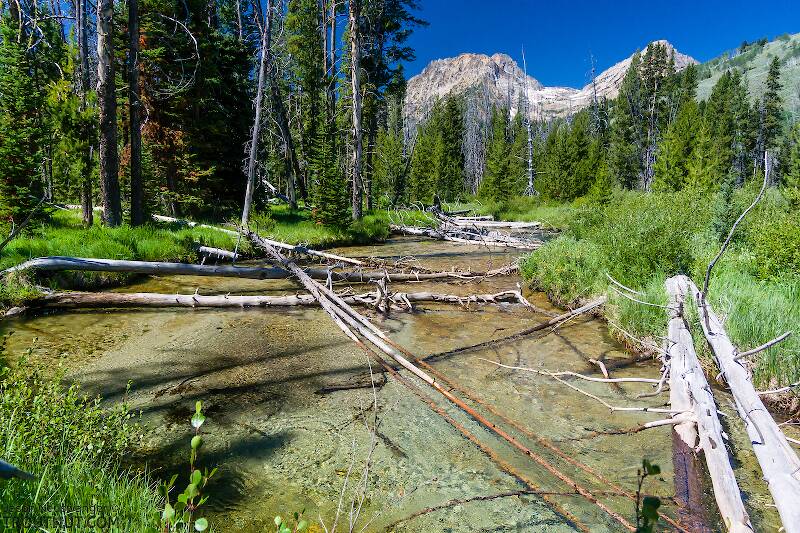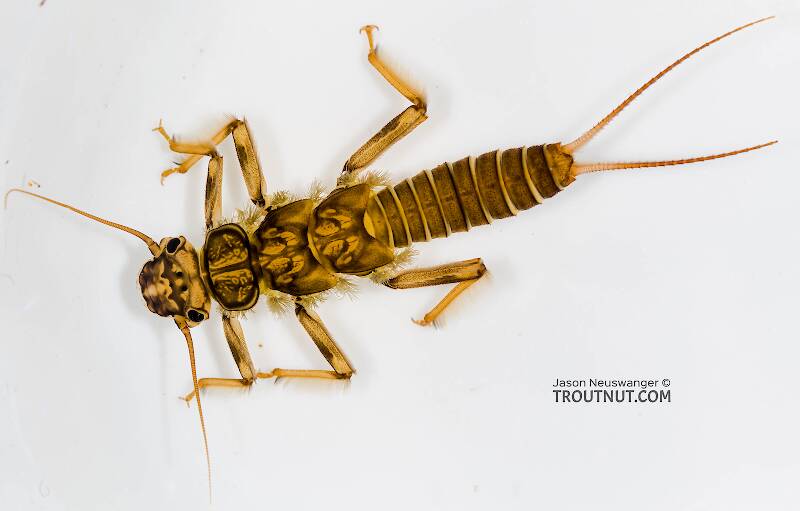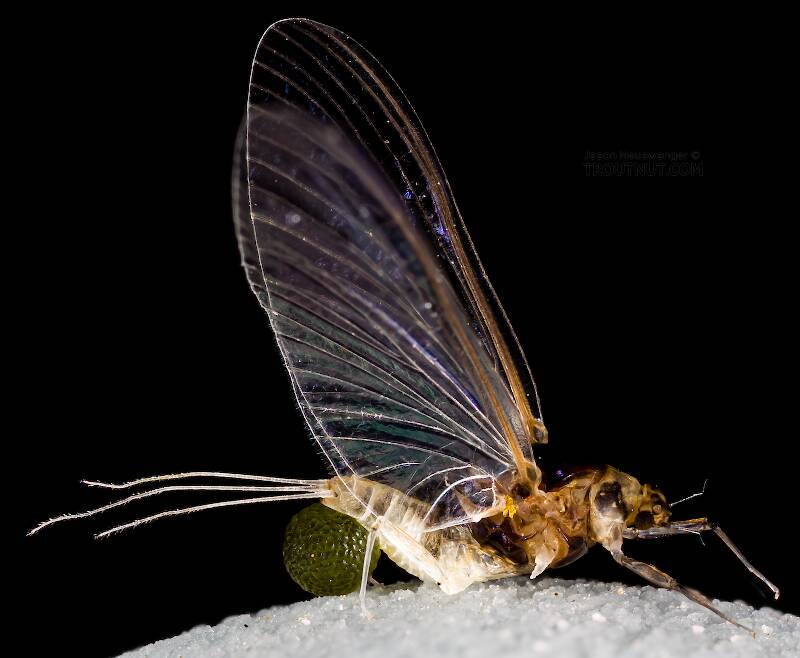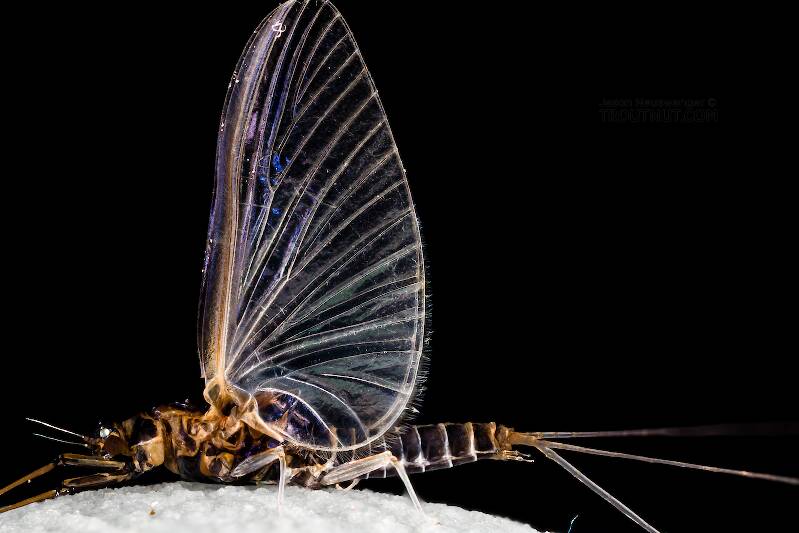
Hex Mayflies
Hexagenia limbata
The famous nocturnal Hex hatch of the Midwest (and a few other lucky locations) stirs to the surface mythically large brown trout that only touch streamers for the rest of the year.
Featured on the forum

Troutnut is a project started in 2003 by salmonid ecologist Jason "Troutnut" Neuswanger to help anglers and
fly tyers unabashedly embrace the entomological side of the sport. Learn more about Troutnut or
support the project for an enhanced experience here.
This topic is about the Mayfly Genus Tricorythodes
A cult following is something to which few insects can lay claim, but the tiny Tricorythodes mayflies certainly qualify. Their widespread, reliable, heavy hatches draw impressive rises of ultra-selective trout which demand the most of a technical dry-fly angler's skills.It is surprising that such a great hatch took so long to come to the attention of fly fishermen. The Tricos were first introduced to anglers in a 1969 Outdoor Life article by Vincent Marinaro, who misidentified them as Caenis. By the early 1970s the identification had been corrected but Swisher and Richards still wrote in Selective Trout, "Few anglers are familiar with these extremely small but important mayflies." The next wave of publications boosted Tricorythodes to its current fame. I suspect their early dismissal was due in part to tackle limitations; anglers in the 1950s had no means to effectively tie and present size 22-28 flies.
Example specimens
IEatimago on Sep 1, 2007September 1st, 2007, 9:47 am EDT
i noticed a small swarm of tricos mating between 330 and 4pm today, is that rare?
the air temp is in the mid to high 70's and its sunny
the air temp is in the mid to high 70's and its sunny
Gene
Posts: 107
Posts: 107
Gene on Sep 1, 2007September 1st, 2007, 4:52 pm EDT
There is a lot of nonsense about tricos. Most of it is propagated by fly fishing writers. I wrote a little booklet on it years ago on some of the research I did on Falling Springs in Chambersburg which had the greatest trico hatch I have ever seen especially for a small stream (but the hatch is just symbol of what it once was there). I even shared some of this research with some so called writers and showed them how to fish the hatch who basically put their name on it and failed to give me credit including the sunken trico which as far as I know I was the first to properly identify. I know that sounds like sour grapes but you can only take so much of this nonsense.
It is not uncommon on some streams to see tricos (if they were really trikes...did you get a sample) in the afternoon. On many streams for instance the trico actually has 3 hatches and spinner falls per day. This is what made Falling Spring such a great stream. In mid- June the hatch really got going. It started around 8:00 a.m There were three major emergences (mostly females early because many males emerge at night and these are the ones who are ready to mate with the first spinner fall). Another one after around 12:30 and then the final around 2:00. As the season progressed the time the hatch patterns got later and later and usually carried to early afternoon. This occurs on many streams and rivers that had a long emergence of trikes. Falling Spring emergence actually started in late May some years with the heaviest usually in August and going until it got cold. Some years it actually went into Nov!
Depending on the temps, humidity cloud cover etc. the trikes will swarm later but often go back to the trees. There is always a chance you have some later hatches because it may nature's method of spreading the species and giving the insects the best chance to survive.
I've seen some late tricos in July on the West Branch of the Delaware years ago so it's not unheard.
tight lines and big trout on tiny flies
gene
www.flyfisher.com
It is not uncommon on some streams to see tricos (if they were really trikes...did you get a sample) in the afternoon. On many streams for instance the trico actually has 3 hatches and spinner falls per day. This is what made Falling Spring such a great stream. In mid- June the hatch really got going. It started around 8:00 a.m There were three major emergences (mostly females early because many males emerge at night and these are the ones who are ready to mate with the first spinner fall). Another one after around 12:30 and then the final around 2:00. As the season progressed the time the hatch patterns got later and later and usually carried to early afternoon. This occurs on many streams and rivers that had a long emergence of trikes. Falling Spring emergence actually started in late May some years with the heaviest usually in August and going until it got cold. Some years it actually went into Nov!
Depending on the temps, humidity cloud cover etc. the trikes will swarm later but often go back to the trees. There is always a chance you have some later hatches because it may nature's method of spreading the species and giving the insects the best chance to survive.
I've seen some late tricos in July on the West Branch of the Delaware years ago so it's not unheard.
tight lines and big trout on tiny flies
gene
www.flyfisher.com
Taxon on Sep 1, 2007September 1st, 2007, 6:16 pm EDT
Hi Gene-
With regard to your research on Falling Springs,
a) did you encounter more than one species of Tricorythodes?
b) did you encounter multiple generations of a single Tricorythodes species?
c) do you have a sense the interplay of a) and b) with regard to the late-May to November emergence period you mentioned?
If you are willing to answer my questions, I would prefer that you refer to the species as they were classified at the time of your research, rather than the way they may currently be classified. I am asking you these questions in the hope of gaining additional insights regarding multivoltine mayflies.
Sincerely,
With regard to your research on Falling Springs,
a) did you encounter more than one species of Tricorythodes?
b) did you encounter multiple generations of a single Tricorythodes species?
c) do you have a sense the interplay of a) and b) with regard to the late-May to November emergence period you mentioned?
If you are willing to answer my questions, I would prefer that you refer to the species as they were classified at the time of your research, rather than the way they may currently be classified. I am asking you these questions in the hope of gaining additional insights regarding multivoltine mayflies.
Sincerely,
IEatimago on Sep 1, 2007September 1st, 2007, 8:59 pm EDT
guido, tell me how does your secret trico technique work!?
Gene
Posts: 107
Posts: 107
Gene on Sep 2, 2007September 2nd, 2007, 5:31 am EDT
Roger:
The Trico was minutus. I believe according to my observations that there were more than 1 generation per year on Falling Spring Run. What happened in terms of the trico is similar to what happened with E. invaria (rotunda back then) is that the flies got smaller as the season progressed. The trikes started at around size 20 and ended up around 26 by the end of the summer. I believe that there was a "bump" in the second generation sometime between late July and Mid August. The bump was the first generation and the second generation emerging at the same time. This is only anecdotal evidence but based on my observations, early in the day the flies were large like the flies that had been emerging. The second and third emergences of the day tended to produce smaller flies. I don't know if this has happened on other stream but Falling Spring was one of the most unique ecosystems in the world before it was destroyed.
As far as the secret techniques these are based on behavioral observations of the fish and then fishing to that fish in a certain way. I still have a few of the booklets if anyone is interested. You can contact me by email (gene@flyfisher.com) or leave a message in the inbox of the forum.
The limestone spring creeks of South Central Pa. were at one time the greatest living laboratories that a fly fisherman could want. If you observed properly you could learn more about trout in one year compared to 20 on most streams.
tight lines and a great days on the rivers of life
gene
www.limestoner.com
The Trico was minutus. I believe according to my observations that there were more than 1 generation per year on Falling Spring Run. What happened in terms of the trico is similar to what happened with E. invaria (rotunda back then) is that the flies got smaller as the season progressed. The trikes started at around size 20 and ended up around 26 by the end of the summer. I believe that there was a "bump" in the second generation sometime between late July and Mid August. The bump was the first generation and the second generation emerging at the same time. This is only anecdotal evidence but based on my observations, early in the day the flies were large like the flies that had been emerging. The second and third emergences of the day tended to produce smaller flies. I don't know if this has happened on other stream but Falling Spring was one of the most unique ecosystems in the world before it was destroyed.
As far as the secret techniques these are based on behavioral observations of the fish and then fishing to that fish in a certain way. I still have a few of the booklets if anyone is interested. You can contact me by email (gene@flyfisher.com) or leave a message in the inbox of the forum.
The limestone spring creeks of South Central Pa. were at one time the greatest living laboratories that a fly fisherman could want. If you observed properly you could learn more about trout in one year compared to 20 on most streams.
tight lines and a great days on the rivers of life
gene
www.limestoner.com
Taxon on Sep 2, 2007September 2nd, 2007, 7:00 am EDT
Gene-
Thanks for sharing that information. It is my belief that (subsequent to) 1st generation-of-year multivoltine mayflies (on a given stream) will generally decrease in size with each succeeding generation-of-year, which is primarily attributable to a decrease in the number of calendar days required to for them to acquire the thermal regimen (degree days) necessary for maturation.
Thanks for sharing that information. It is my belief that (subsequent to) 1st generation-of-year multivoltine mayflies (on a given stream) will generally decrease in size with each succeeding generation-of-year, which is primarily attributable to a decrease in the number of calendar days required to for them to acquire the thermal regimen (degree days) necessary for maturation.
Gene
Posts: 107
Posts: 107
Gene on Sep 2, 2007September 2nd, 2007, 10:16 am EDT
Roger:
Sorry to upset your apple cart on this one but your analysis does hold true probably in a non spring ecosystem. My observations may be true for trikes but not always other multi generation creatures. But in spring creeks like Big Spring, Falling Spring, Letort etc. some multiple generation insects and invertebrates are the same size through out each generation. For example, the Baetis group. Of course, there are many sizes of these as they do change but spring creeks have a temperature regime of 46 to 50 degrees. This is unlike a freestone stream which exhibits temperature range maybe from 33 to 80 degrees.
So it really depends upon the insect and the temperature of the stream. Spring creeks are basically controlled by light and many of the other environmental influences including floods, gouging, micro floral periodicity is different on spring creek than on a freestone stream and thus organisms have different growth periods. Another example would be scuds (such as Gammarus) and cressbugs (Asellus) have many generations per year and they all reach basically mature sizes.
tight lines and magic days streams side
gene
www.flyfisher.com
Sorry to upset your apple cart on this one but your analysis does hold true probably in a non spring ecosystem. My observations may be true for trikes but not always other multi generation creatures. But in spring creeks like Big Spring, Falling Spring, Letort etc. some multiple generation insects and invertebrates are the same size through out each generation. For example, the Baetis group. Of course, there are many sizes of these as they do change but spring creeks have a temperature regime of 46 to 50 degrees. This is unlike a freestone stream which exhibits temperature range maybe from 33 to 80 degrees.
So it really depends upon the insect and the temperature of the stream. Spring creeks are basically controlled by light and many of the other environmental influences including floods, gouging, micro floral periodicity is different on spring creek than on a freestone stream and thus organisms have different growth periods. Another example would be scuds (such as Gammarus) and cressbugs (Asellus) have many generations per year and they all reach basically mature sizes.
tight lines and magic days streams side
gene
www.flyfisher.com
Taxon on Sep 2, 2007September 2nd, 2007, 6:03 pm EDT
Gene-
As I understand your response, you don't necessarily disagree with the theory, except it has little application on a spring creek, where there is extremely limited seasonal water temperature variation, as opposed to a freestone stream, which characteristically has extreme seasonal water temperature variation. Is that a reasonably accurate interpretation of your response?
As I understand your response, you don't necessarily disagree with the theory, except it has little application on a spring creek, where there is extremely limited seasonal water temperature variation, as opposed to a freestone stream, which characteristically has extreme seasonal water temperature variation. Is that a reasonably accurate interpretation of your response?
Gene
Posts: 107
Posts: 107
Gene on Sep 3, 2007September 3rd, 2007, 5:49 am EDT
Roger:
I subscribe to what you are saying too but just remember there are few absolutes especially on a spring creek (or perhaps a spring influenced stream where you may get a local population of something different from a general population of the same insect elsewhere. A prime example of this would E. leukon on the Yellow Breeches in Boiling Spring Pa. The White Fly E. leukon comes off typically in July on the Potomac, Susquehanna and even on other parts of the Breeches as well as other streams and rivers. But on the Yellow Breeches below Boiling Springs it's late August to Sept. because the giant spring coming out of Boiling Spring lake empties into the stream at this point and moderates the temps giving portions of the Yellow Breeches, "A spring creek effect").
I think that may be reasonable for the trikes and that's my observation too. I have only anecdotal evidence however in the form of the size of the adults in August and also smaller mature nymphs compared to earlier trike nymphs. Unfortunately, the stream has been raped so I can't go out and do a follow-up study on it.
I have a theory on these multi-generation insects. I'll throw it out for you and everyone who is interested. Mayflies like Baetis which have multi-generations per year evolved that way and therefore the sizes in at least some generations are very similar. Tricos and other insects which undergo multi-generation cycles are the result of environmental conditions (like the spring creek) and therefore are more likely to have size differences for the generations. Just some observations in my head.
tight lines and a great fall fishing for all
gene
www.eugenemacri.com
I subscribe to what you are saying too but just remember there are few absolutes especially on a spring creek (or perhaps a spring influenced stream where you may get a local population of something different from a general population of the same insect elsewhere. A prime example of this would E. leukon on the Yellow Breeches in Boiling Spring Pa. The White Fly E. leukon comes off typically in July on the Potomac, Susquehanna and even on other parts of the Breeches as well as other streams and rivers. But on the Yellow Breeches below Boiling Springs it's late August to Sept. because the giant spring coming out of Boiling Spring lake empties into the stream at this point and moderates the temps giving portions of the Yellow Breeches, "A spring creek effect").
I think that may be reasonable for the trikes and that's my observation too. I have only anecdotal evidence however in the form of the size of the adults in August and also smaller mature nymphs compared to earlier trike nymphs. Unfortunately, the stream has been raped so I can't go out and do a follow-up study on it.
I have a theory on these multi-generation insects. I'll throw it out for you and everyone who is interested. Mayflies like Baetis which have multi-generations per year evolved that way and therefore the sizes in at least some generations are very similar. Tricos and other insects which undergo multi-generation cycles are the result of environmental conditions (like the spring creek) and therefore are more likely to have size differences for the generations. Just some observations in my head.
tight lines and a great fall fishing for all
gene
www.eugenemacri.com
Quick Reply
Related Discussions
Topic
Replies
Last Reply
2
Jul 9, 2018
by Martinlf
by Martinlf
6
Oct 25, 2008
by Taxon
by Taxon
6
Nov 12, 2006
by Martinlf
by Martinlf






